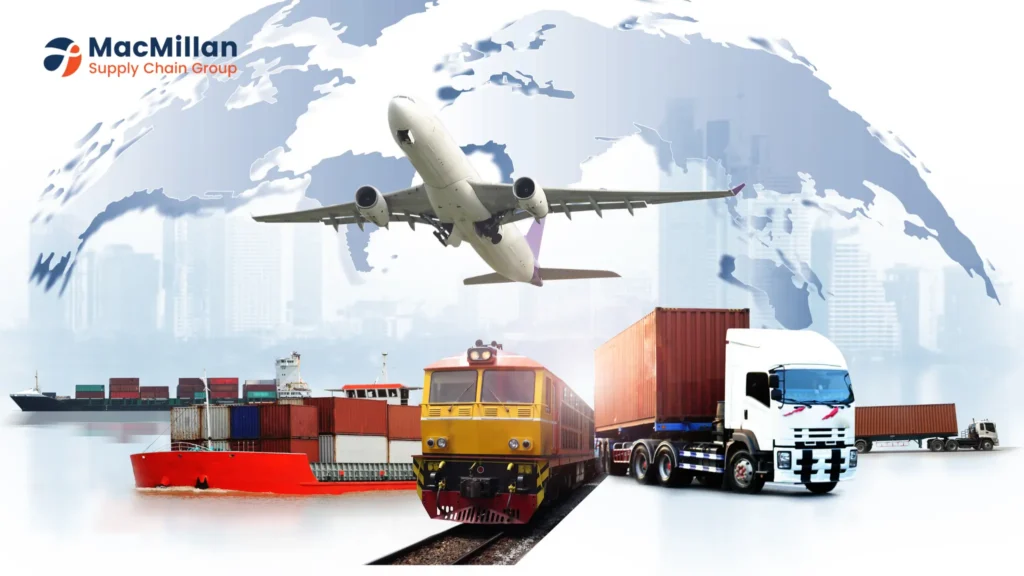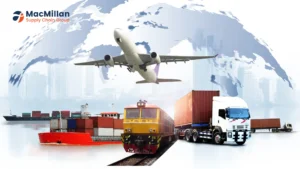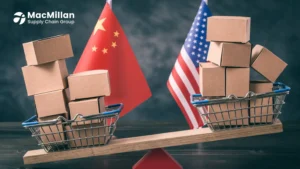The intricate movement of goods across national borders is known as international logistics, and it calls for knowledge of distribution, warehousing, transportation, and customs clearance. Knowing the basics of cross-border operations is crucial for companies growing internationally to succeed. From choosing modes of transportation to overseeing cross-border warehousing and fulfillment, this guide examines important aspects of international logistics. MacMillan Supply Chain Group provides the infrastructure and experience to effectively handle international logistics challenges, regardless of your level of experience with international trade or your desire to streamline current operations.
Introduction: Understanding International Logistics
Have you ever pondered how goods from around the globe make their way to your neighborhood shops or homes? International logistics the difficult process of transporting goods across borders while negotiating complex regulations, transportation networks, and fulfillment systems holds the key to the solution.
Choosing the best shipping option, overseeing cross-border storage, and guaranteeing efficient customs clearance are all included in international logistics. Gaining proficiency in these areas is essential for companies growing outside of their home markets in order to preserve their competitive edge and client satisfaction.
International shipping presents special difficulties for Canadian companies in the linked economy of today. Given Canada’s size and closeness to the US market, businesses require strategic approaches to fulfillment and warehousing that strike a balance between speed, cost, and compliance. Knowing the basics of international logistics can mean the difference between success and expensive errors, whether you’re shipping from Vancouver to Vienna or Toronto to Tokyo.
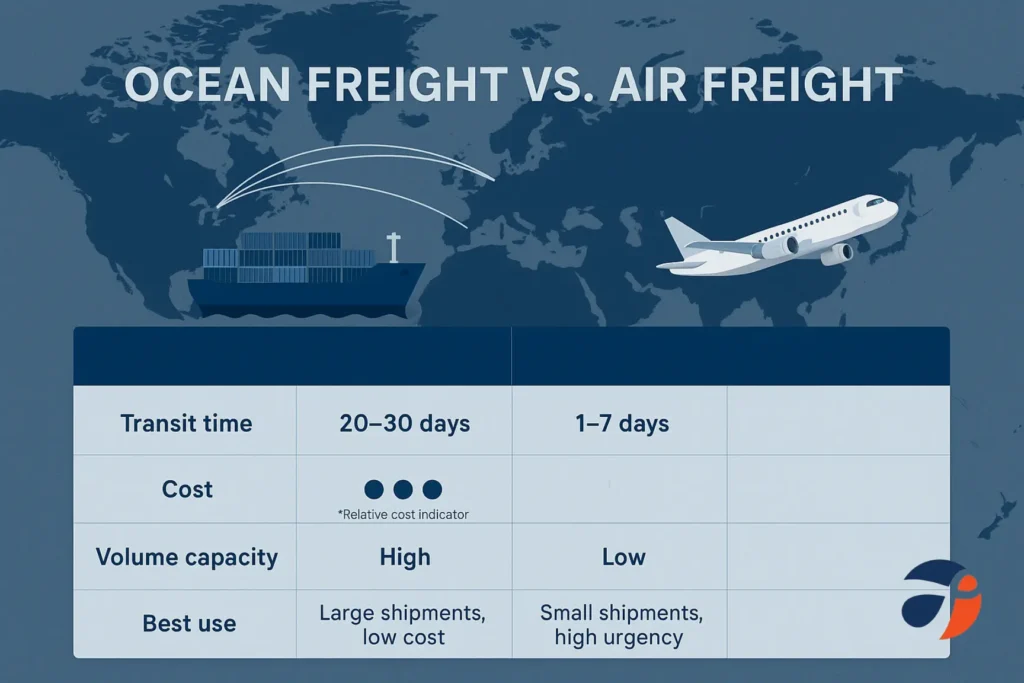
Options for International Shipping Transportation
Ocean Freight: The Foundation of International Logistics
The most economical way to transport big loads of goods across international borders is still by sea. It’s critical for Canadian companies shipping abroad to comprehend their container options:
- Full Container Load (FCL): FCL provides superior security and possibly lower prices per unit when your shipment fills an entire container.
- Least than Container Load (LCL): LCL enables you to share container space with other shippers for smaller shipments, making ocean freight feasible even for small volumes.
It usually takes 20 to 30 days for ocean freight from Asia to Canadian ports, which makes it perfect for routine inventory replenishment or non-urgent shipments. Although ocean shipping is slower than air freight, it is usually 4-6 times less expensive, making it the best choice for large orders or bulky items.
According to logistics specialists at MacMillan Supply Chain, “timing is everything when planning international logistics.” “Ocean freight offers outstanding value for routine inventory movements, but it requires longer lead times if planned properly.“
Air Freight: Speed When It Matters Most
When time is critical, air freight becomes the go-to solution for international logistics. Air freight Canada services connect businesses to global markets in days rather than weeks:
- Express Air Freight: Can deliver in as little as 1-3 days for urgent shipments; Standard Air Freight: Usually delivers in 5-7 days internationally.
Despite being more expensive than ocean shipping, air freight has benefits beyond speed. Products travel less, which lowers the risk of damage and the cost of carrying inventory. The higher cost of air freight is frequently justified by increased cash flow and customer satisfaction for valuable items, perishables, or urgent shipments.
International Warehousing Techniques
Placement of the Warehouse Strategically
The global location of your inventory has a significant impact on shipping costs and delivery times. Cross-border warehousing solutions give companies the freedom to effectively service global markets:
Border-Adjacent Warehousing: Facilities near major crossing points between Canada and the U.S. facilitate smooth cross-border commerce
Regional Distribution Centers: Strategic warehouses in key markets reduce last-mile delivery times and costs
Foreign Trade Zones: Special warehousing areas that allow duty deferment until products enter the domestic market
MacMillan Supply Chain Group operates strategically located warehouses throughout Canada, providing businesses with flexible storage solutions that minimize transit times and customs delays. Businesses can lower shipping costs and increase delivery times by putting inventory closer to end users.
Managing Inventory in International Logistics
International inventory management poses special difficulties. Advanced systems are necessary for efficient international logistics in order to track inventory levels, keep an eye on movement, and guarantee that goods are available when and where they are needed.
Contemporary warehouse management systems give companies real-time visibility across international facilities, allowing them to:
- Ensure that inventory levels are balanced across foreign locations.
- Expect variations in regional demand.
- Improved forecasting can lower the need for safety stock.
- Reduce delays caused by customs by using the right paperwork.
According to supply chain experts, “having facilities in multiple countries isn’t the key to successful international warehousing.” “It’s having the systems and knowledge to run those facilities as a unified global logistics network.”
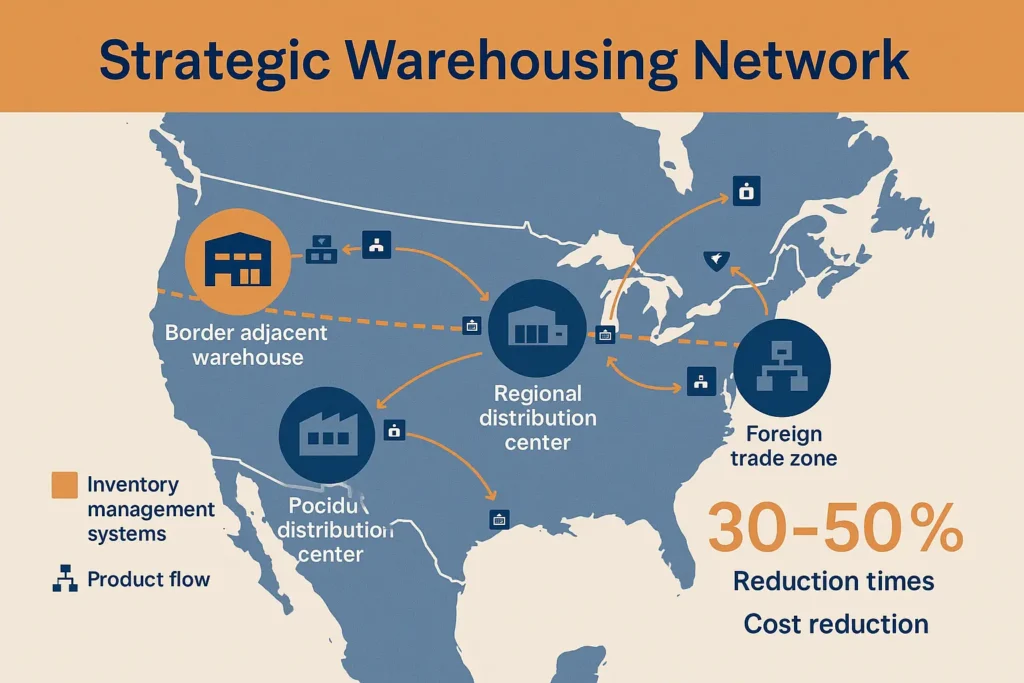
Managing Compliance and Customs
Comprehending Customs Clearance
Navigating customs clearance procedures is one of the most difficult parts of international logistics. Every nation has different regulations, standards for documentation, and things that are not allowed. Working with knowledgeable customs brokers is crucial for companies shipping between Canada and foreign locations.
Customs clearance typically requires:
- Commercial invoices with accurate product descriptions and values
- Certificates of origin documenting where products were manufactured
- Bills of lading or air waybills detailing transportation information
- Proper classification of goods under Harmonized System (HS) codes
Shipment delays, extra inspections, or even fines may result from mistakes in customs paperwork. Working with a reputable freight forwarder in Canada, such as MacMillan Supply Chain Group, helps guarantee adherence to all applicable laws.
Import/Export Laws and Adherence
Navigating intricate import/export laws that differ by nation and product type is part of international logistics, which goes beyond simple customs clearance. These could consist of:
- Certifications or testing specifications unique to a product
- Items that are restricted or forbidden
- Quota restrictions on specific product categories; special licensing for controlled goods
Staying compliant with these regulations requires ongoing vigilance and expertise. As regulations change frequently, businesses engaged in international trade need partners who actively monitor regulatory developments and adapt procedures accordingly.
Common Problems with International Logistics
Numerous obstacles in international logistics have the potential to upset supply chains and lower customer satisfaction. Typical issues include:
- Customs Delays: Shipments may be held at borders for days or weeks due to incomplete paperwork or incorrect classification.
- Transportation Disruptions: Shipments may be delayed by bad weather, port traffic, or carrier problems.
- Inventory Imbalances: Having trouble keeping the right amount of inventory in several foreign locations
- Compliance Violations: Unintentional violations of import/export laws that result in fines
- Visibility Gaps: Inability to monitor shipments from abroad
- Cost Management: Unpredictable expenses, including taxes, duties, and surcharges
- Processing Returns: Challenges in International Reverse Logistics
- Communication Challenges with International Partners Due to Language and Cultural Barriers
These difficulties can have a big effect on how businesses operate, which can result in higher expenses, unhappy customers, and lost chances in foreign markets.
Our Answers: MacMillan’s Method for International Logistics
We at MacMillan Supply Chain Group have created all-inclusive solutions to deal with the challenges of international logistics. Our integrated approach creates smooth cross-border operations by combining strategic warehousing, transportation expertise, and cutting-edge technology.
Transportation Management Integrated
For every international move, our transportation management solutions provide companies with the best shipping choices:
Carrier Selection: We keep up with reputable air and sea carriers to guarantee dependable service and affordable prices.
Route Optimization: Our professionals find the most cost-effective routes, balancing speed and cost according to your unique needs.
Documentation Support: The risk of customs delays is decreased by our handling of complicated international shipping documentation. –
Visibility Tools: Complete shipment visibility is provided by real-time tracking across all modes of transportation.
Our transportation experience reduces transit times and keeps costs under control for companies shipping from Canada to foreign locations. To increase efficiency, we bargain with carriers for lower prices and, when practical, combine shipments.
Strategic Cross-Border Warehousing
MacMillan’s network of warehousing facilities supports efficient international logistics operations:
- Border-Adjacent Facilities: Our warehouses near key crossing points facilitate smooth movement between Canada and the U.S.
- Flexible Storage Options: We accommodate your evolving needs with a range of flexible storage options, from long-term storage to short-term cross-docking.
- Value-Added Services: Labeling, repackaging, and kitting are examples of value-added services. Get your goods ready for particular foreign markets by implementing
- Inventory Optimization: Stock levels are balanced across locations by sophisticated inventory management systems.
With the help of our warehousing solutions, companies can strategically place inventory, cutting down on delivery times and transportation expenses while preserving the best possible service standards across all markets.
Customs and Compliance Expertise
Customs experts who handle the complexity of global regulations are part of our team:
- Documentation Preparation: We make sure that all necessary customs documents are accurate and complete.
- HS Code Classification: Correct classification of goods saves time and guarantees accurate duty assessment.
- Regulatory Monitoring: We keep up with changes to import/export laws that impact your products.
- Duty and Tax Management: Methodical ways to reduce duties while ensuring complete compliance.
Businesses that work with MacMillan have access to customs knowledge that helps them avoid expensive delays and compliance problems.
Technology-Driven Visibility
Our technological platform offers complete visibility into global supply chains:
- Unified Tracking: Track shipments via all shipping methods and warehouses;
- Inventory Visibility: Track stock levels in real time across international facilities;
- Document Management: Store and retrieve all shipping and customs paperwork digitally;
- Performance Analytics: Evaluate and improve the performance of international logistics
Proactive management of international shipments is made possible by this visibility, which enables companies to spot possible problems early on and take action before they affect clients.
How to Put Successful International Logistics Solutions into Practice
Effective international logistics implementation necessitates careful planning and the appropriate alliances. Here are some tips for improving your cross-border business operations:
Evaluate Your Present Foreign Operations
Examine your current international logistics procedures first:
Determine current cross-border movement pain points; determine total landed costs for international shipments; gauge current international customer delivery times; and examine compliance procedures and documentation requirements.
This assessment provides a starting point for advancement and identifies priority areas for improvement.
Create a Strategic Plan
Create a strategic plan for international logistics based on your assessment:
- Identify the best locations for inventory in each market.
- Choose the best modes of transportation for the various product categories.
- Create compliance procedures and documentation standards.
- Put technological solutions for control and visibility into practice.
A thorough plan tackles particular operational issues while coordinating global logistics with overarching business goals.
Join forces with MacMillan Supply Chain Group
Working with a seasoned 3PL provider like MacMillan Supply Chain Group is the best strategy to maximize international logistics. Our all-inclusive services lower expenses and increase customer satisfaction while streamlining cross-border operations.
Are you prepared to revolutionize your international logistics? To find out how our fulfillment, shipping, and warehousing solutions can improve your cross-border operations, get in touch with MacMillan Supply Chain Group right now. Our team of professionals will assess your unique requirements and create a tailored international logistics strategy that promotes customer satisfaction and business expansion.
You can cross international borders with assurance when MacMillan is your logistics partner because you know that your products will reach international markets effectively, legally, and economically.
FAQS
When you ship enough goods to fill an entire container, you are granted exclusive use of that space, which is known as full container load, or FCL. When you don't have enough volume to fill a container, you can share container space with other shippers using LCL (Less than Container Load). While LCL offers flexibility for smaller shipments, FCL usually offers better security and possibly lower costs per unit.
Take into account three important elements: volume, shipment value, and time sensitivity. Ocean freight is more effective for larger shipments that are not time-sensitive, while air freight is best for smaller volumes, high-value items, and urgent shipments. For instance, furniture usually ships by sea, but seasonal fashion may warrant air freight. To make the best choice, figure out the entire landed cost, including inventory carrying costs.
Commercial invoices (which include product descriptions, quantities, and values), packing lists, air waybills or bills of lading, certificates of origin, and customs declarations are all necessary documents. Additionally, you may require specific licenses, certifications, or inspection certificates, depending on the product and destination. Using a freight forwarder such as MacMillan Supply Chain Group guarantees that all paperwork is ready.
Assure proper product classification with appropriate HS codes, offer comprehensive and consistent documentation, collaborate with knowledgeable customs brokers, and think about taking part in reliable trader programs such as Partners in Protection (PIP) or Canada's Customs Self Assessment (CSA). Customs procedures can also be sped up by keeping thorough product information and, when feasible, pre-clearing shipments.
Standardized international trade terms known as Incoterms outline the obligations of both buyers and sellers in cross-border transactions. They outline who is responsible for handling customs clearance, who arranges and finances transportation, and who assumes risk during transit. FOB (Free on Board), DDP (Delivered Duty Paid), and EXW (Ex Works) are common terms. By using the appropriate Incoterm in your contracts, you can avoid miscommunications and unforeseen expenses.
Returns from overseas need to be carefully planned. Make sure that all returns are properly documented for customs when they cross borders, establish clear return policies that take cross-border movement into account, and think about keeping return processing centers in strategic markets to prevent international shipping for every return. To manage the challenges of processing international returns, many companies collaborate with 3PLs such as MacMillan Supply Chain Group.
The following are important technologies: global trade management software for customs compliance, warehouse management systems (WMS) for inventory control across locations, transportation management systems (TMS) for shipment planning and tracking, and visibility platforms that offer end-to-end tracking. A unified perspective of global supply chains is produced by the integration of these systems.
Perishable goods must be shipped internationally using temperature-controlled transportation (reefer containers or specialized air freight services), suitable packaging to maintain the necessary conditions, temperature monitoring equipment, accelerated customs clearance procedures, and the right paperwork, including health certificates. For perishable shipping to be successful, collaborating with logistics companies that have cold chain management experience is crucial.
Established carrier relationships, volume discounts, customs knowledge, international warehousing networks, specialized technology, and experience navigating international regulations are all provided by third-party logistics providers (3PLs) such as MacMillan Supply Chain Group. This knowledge lowers expenses, cuts down on delays, enhances compliance, and frees up companies to concentrate on their core skills rather than the intricacies of logistics.
Analyzing customer locations and demand trends, determining the best stocking points to balance costs and service levels, taking into account duties and taxes in various locations, assessing transportation networks from possible warehousing sites, and putting in place technology that offers visibility across all inventory locations are all part of strategic inventory placement. A hub-and-spoke model is employed by many companies, with regional distribution centers catering to particular foreign markets.
